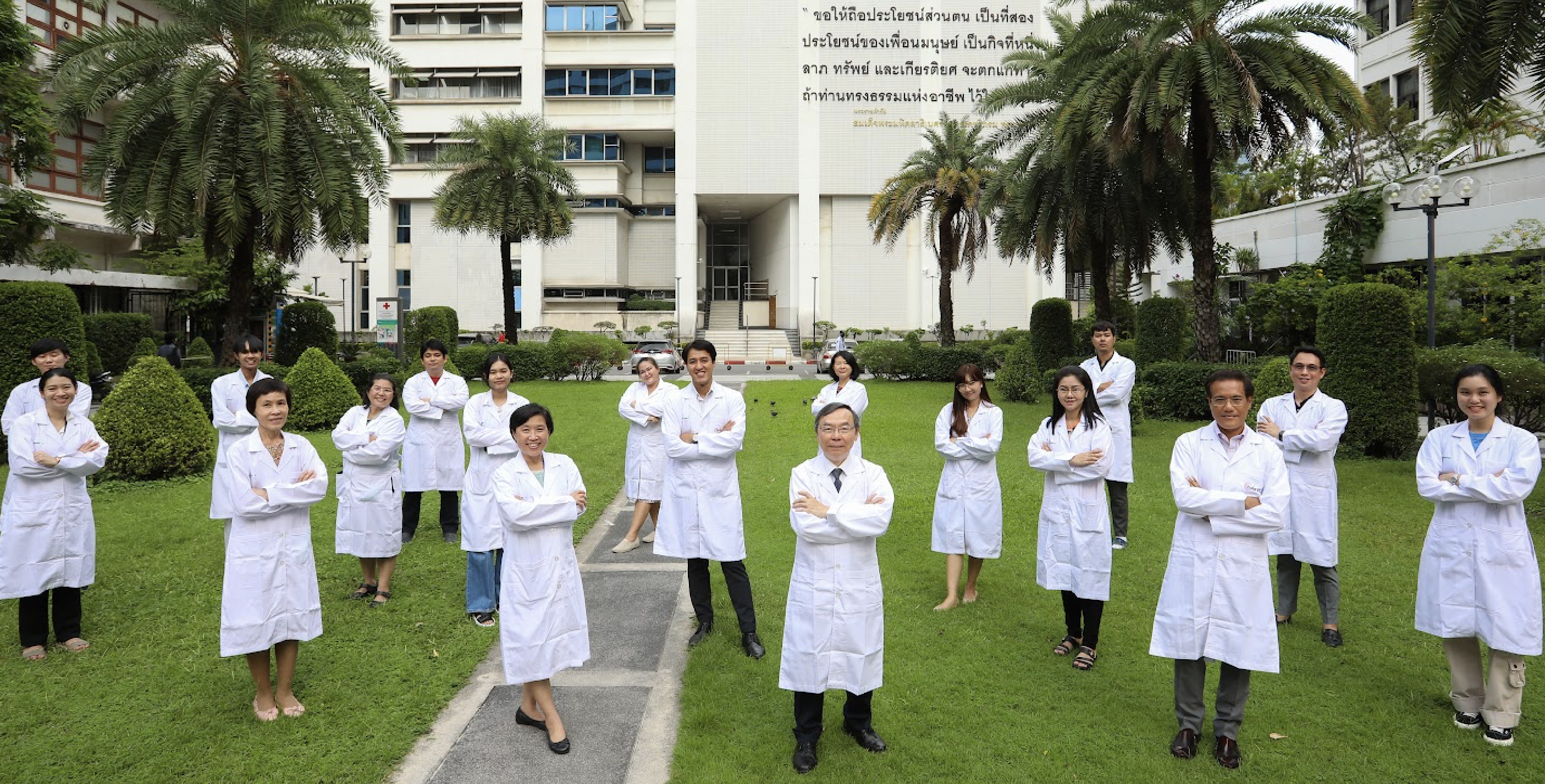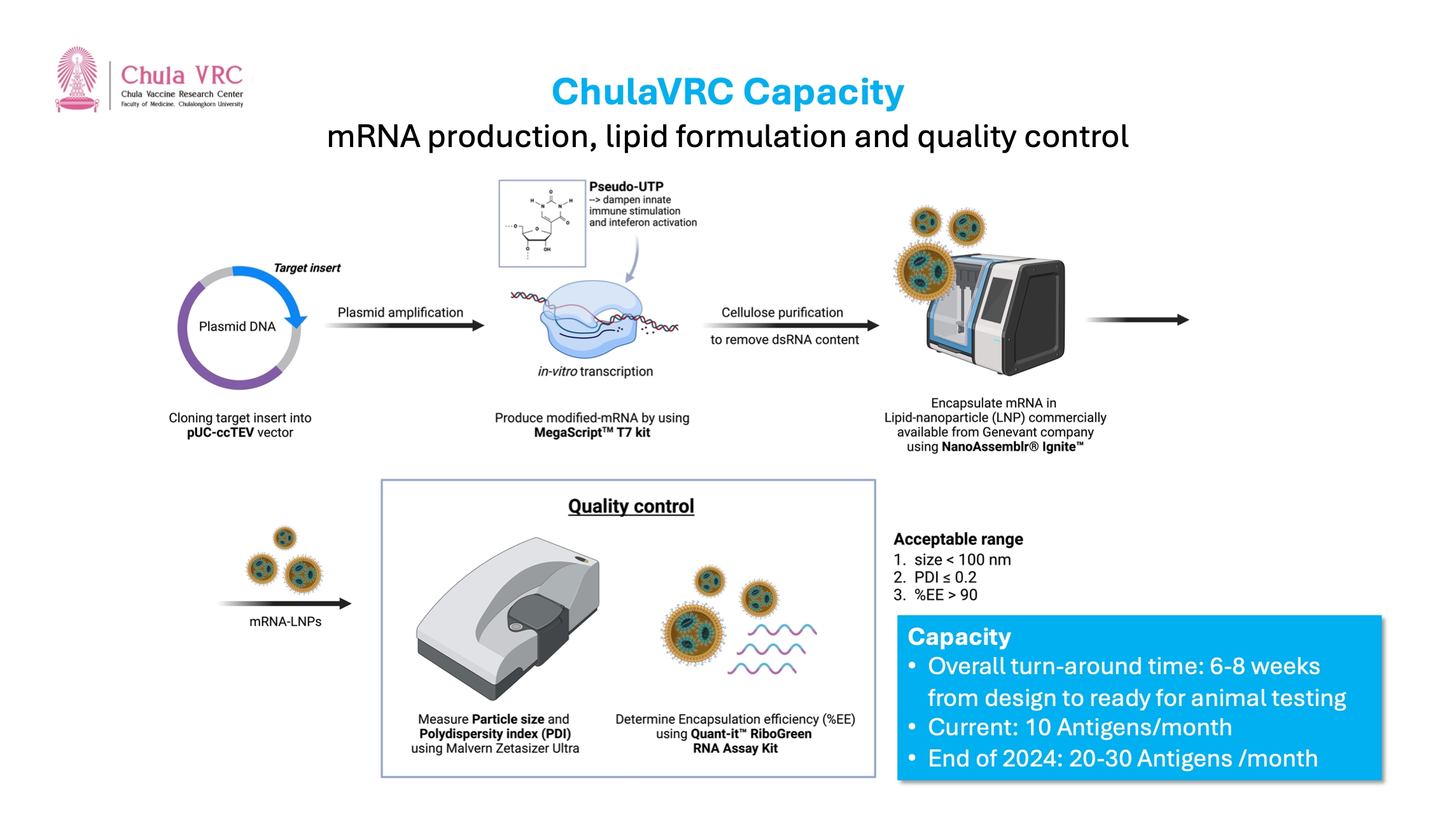
Chula Vaccine Research Center
The Center of Excellence in Vaccine Research and Development, Chulalongkorn University
Center of Excellence in Vaccine Research and Development or Chula VRC was formally established in 2017. Chula VRC consists of faculty staffs and researchers with common interest in vaccine research and development to work together and share their knowledge and experience leading to the strength of the team. ChulaVRC has been collaborating with Prof. Drew Weissman of U. Pennsylvania since 2017 to set up mRNA vaccine R&D capacity with the commitment and mission to join the global effort to make pandemic vaccines and unmet need vaccines accessible to low- and middle-income countries.
Chula VRC focuses not only on vaccines against infectious diseases, such as Covid-19, dengue fever, leptospirosis, and emerging infections including novel corona virus disease (COVID-19) but also vaccines against non-infectious diseases including allergy vaccine.
The mission of Chula VRC is to “develop and deliver effective, safe, and affordable vaccines” for domestic use in Thailand and our neighboring low-income countries.
Current and near future Chula VRC’s capacity

As summarized in the above figure, Chula VRC is able to conduct for almost complete R&D capacity chain of a mRNA vaccine candidate from the antigen design to mRNA production, LNP encapsulation, in vitro and in vivo preclinical testing. And Chula VRC has experience in sponsoring and coordinating CDMO clinical lot production and clinical trials. ChulaCov19, ChulaVRC initiative, Bivalent Covid-19 mRNA vaccine has completed its Phase 2 trial enrollment in Thailand and Australia.
Currently, Chula VRC can produce mRNA/LNP immunogens for approximately 10 immunogens per month, however with the new facility, we will be able to produce up to 30 mRNA/LNP immunogens per month. In average each vaccine candidate can move from starting antigen design to finish and ready for animal studies by 8 weeks (see the figure below). By early 2025, Chula VRC will finish establishing a small but efficient GMP facility to produce clinical lot to help speeding up the early clinical develop both for ChulaVRC- or other collaborator-initiated vaccine in a cost-effective strategy.

Current and Future mRNA Vaccine Development
- ChulaVRC initiated vaccine: 1). with promising results in animal – Dengue, therapeutic HPV, house dust mite vaccine. 2). In developing: Leptospirosis, Avian flu, TB, and AMR (Acinetobacter baumanii)
- Collaborator initiated vaccine: 1). In animal testing: P. vivax 2). In developing: HFMD
International Networks
- ChulaVRC is joining the WHO mRNA tech transfer hub particularly playing key role on the R&D of 4 target vaccines.
- ChulaVRC, Prof. Kiat Ruxrungtham, is a co-director and co-PI with Prof. Tuck Seng Wong, Sheffield U of the recent grant awarded “UK-SEA Vaccine Manufacturing Research Hub”
Major sources of Funding Support:
National Vaccine Institutes (NVI), Governmental Covid-19 pandemic fund, Chulalongkorn U, Faculty of Medicine and Public Donation
Selected major publications:
- Gatechompol, S., Kittanamongkolchai, W., Ketloy, C. et al. Safety and immunogenicity of a prefusion non-stabilized spike protein mRNA COVID-19 vaccine: a phase I trial. Nat Microbiol 7, 1987–1995 (2022).
- Prompetchara, E., Ketloy, C., Alameh, MG. et al. Immunogenicity and protective efficacy of SARS-CoV-2 mRNA vaccine encoding secreted non-stabilized spike in female mice. Nat Commun 14, 2309 (2023).
- Puthanakit, T., Prompetchara, E., Gatechompol, S. et al. Phase II prefusion non-stabilised Covid-19 mRNA vaccine randomised study. Sci Rep 14, 2373 (2024).
- Torreele E, Wolfe D, Kazatchkine M, Sall A, Ruxrungtham K, Fitchett JRA, Liu J, Kobinger G, Vaca-González C, Gómez C, Terblanche P, Swaminathan S, Olliaro P, Clark H. From private incentives to public health need: rethinking research and development for pandemic preparedness. Lancet Glob Health. 2023.
- Phoka T, Thanuthanakhun N, Visitchanakun P, Dueanphen N, Wanichwecharungruang, N, Leelahavanichkul A, Palaga T, Ruxrungtham K, Wanichwecharungruang S. Detachable-dissolvable-microneedle as a potent subunit vaccine delivery device that requires no cold-chain. Vaccine X. 2023.
- Farlow A, Torreele E, Gray G, Ruxrungtham K, Rees H, Prasad S, Gomez C, Sall A, Magalhães J, Olliaro P, Terblanche P. The Future of Epidemic and Pandemic Vaccines to Serve Global Public Health Needs. Vaccines (Basel). 2023 Mar 17;11(3):690.
- Torreele E, McNab C, Adeyi O, Bonnell R, Dhaliwal M, Hassan F, Kazatchkine M, Kim H, Kim J, Legido-Quigley H, Liu J, Nishtar S, Ruxrungtham K, Terblanche P, Todd E, da Silva Freire M, Velásquez G, Sirleaf EJ, Clark H. It is time for ambitious, transformational change to the epidemic countermeasures ecosystem. Lancet. 2023.
Focus Areas
Development of COVID-19 vaccine
- Safety and immunogenicity study of COVID-19 mRNA-based vaccine in both mice and non-human primate
- Immunogenicity study of COVID-19 DNA vaccine in mice
- Immunogenicity study of COVID-19 subunit vaccine in mice
Development of nanoparticle-based dengue DNA vaccine
Development of subunit vaccines against leptospirosis
- Surface-exposed outer membrane proteins as novel subunit vaccines against leptospirosis in a hamster model
- Evaluation of liposome-based adjuvants to promote protective efficacy of LigAc subunit vaccine of leptospirosis in a hamster model
- Surface proteomics of pathogenic Leptospira to search for novel vaccine candidates and diagnostic tests
- Study of immune responses of dendritic cells against Leptospira infection
Development of vaccines for prevention and treatment of HDM allergy
- mRNA vaccines encoding major house dust mite (HDM) allergens
- Development of virus like particles (VLPs) displaying HDM allergens for new immunotherapeutic approaches.
- Production of recombinant house dust mite allergens for in-vitro diagnosis of allergen-specific IgE
- Characterization of innate immune signaling triggered by HDM allergens at the level of airway epithelium

